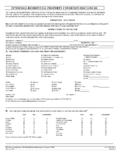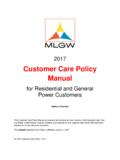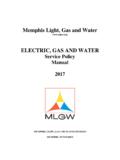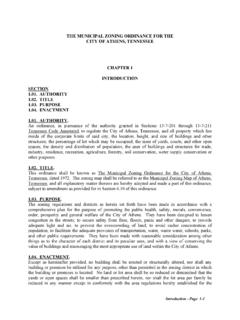Transcription of Design Criteria & Specs. for Pressure Sewers, Force …
1 Design Criteria AND SPECIFICATIONS FOR Pressure SEWERS, Force MAINS, grinder pumps AND APPURTENANCES TUB DECEMBER 2014 TABLE OF CONTENTS Detailed Specifications Section 1 Pressure Sewers and Force Mains Pages 1 - 18 Section 2 grinder pumps and Appurtenances Pages 19 - 26 Standard Drawings Standard Installation Details Pages 27 - 31 These specifications give the minimum requirements for installation of Pressure sewer lines, Force mains and appurtenances in the City of Tullahoma, Tennessee. Any special construction problems or conditions not covered under these Specifications shall be submitted to TUB for approval.
2 The standard drawings are a part of these Specifications and all construction shall conform to the details shown on the drawings. 1 SECTION 1 Pressure SEWERS AND Force MAINS 1. Scope of Work The work to be accomplished under this Section consists of the furnishing of all labor, materials, equipment, and services necessary for the construction of low Pressure Force mains and the Force mains between the central pumping stations and gravity interceptor sewers. The low Pressure sewer system to be constructed will incorporate a number of individual grinder pumps which will pump the sewage generated at the various residential, institutional and commercial establishments through a complete network of low Pressure Force mains.
3 The wastewater will be discharged directly into gravity collector sewers or may be re-pumped by conventional sewage pumps located in central pumping stations through separate Force mains to gravity interceptor sewers. Any contractor, developer, or individual planning to install a Pressure sewer system in a new or unsewered development shall submit detailed plans prepared by a registered engineer in compliance with TUB Standard Specifications and Details and all applicable State requirements to TUB and the Tennessee Department of Environment and Conservation Division of Water Resources for review and approval. The grinder pump installations and associated appurtenances are covered under Section 2 grinder pumps and Appurtenances.
4 2. Location of Force Mains The final location of Force mains as constructed may vary from the approved plans with the approval of TUB provided (1) the proposed location is approved by the Tennessee Department of Transportation, the City of Tullahoma or other agencies or legal entities having jurisdiction; and (2) the effect lessens the project cost. The final location in any event may be varied by necessity due to construction conditions at the direction of TUB due to requirement of the Tennessee Department of Transportation, the City of Tullahoma or other agency or legal entity having jurisdiction. 3. Pipe Fittings for Force Mains a. General In all areas where ductile iron pipe is not specifically shown, Force mains and/or pump lines may be either Class 50 or 51 ductile iron or 200 psi SDR 21 PVC pipe.
5 B. Ductile Iron Pipe 2 Pipe shall be centrifugally cast, manufactured in accordance with the ANSI Specification , of Ductile Cast Iron, Grade 6-42-10, for the required operating pressures as shown on the Plans plus surge allowance of 100 psi, for five feet maximum cover for laying condition B . Each pipe shall be hydrostatically tested, before shipment, to a minimum of 500 psi. Minimum nominal metal thickness shall be: Size 3 4 6 8 10 Class 50 Class 51 Joints shall be push-on joint incorporating a single molded rubber ring gasket, Type II, per Federal Specifications WW-P-42lb such as Fastite , Tyton or Super Bell-Tite unless otherwise indicated on the Plans or hereinafter in these Specifications.
6 Pipe shall be in nominal 16 , 18 , or 20 lengths. Pipe shall be furnished with bituminous exterior coating and the manufacturer s standard Enameline inside to comply with ANSI Specification c. Cast or Ductile Iron Fittings All fittings for ductile iron pipe shall be Class 250 mechanical joint cast iron conforming to ANSI Specifications and or ductile iron conforming to ANSI Specification , and shall meet the current requirements for the manufacturer s standards. Fittings shown on the Plans are intended to convey the general configuration, but the contractor shall furnish all fittings required. Each fitting shall be certified by the manufacturer to have been tested and to have met the requirements of the governing standard specifications.
7 All fittings shall be furnished tar coated outside and the manufacturer s standard Enameline inside to comply with ANSI Specification d. Polyvinyl Chloride Pipe (1) Polyvinyl Chloride pipe for Force mains shall be made from Type 1, Grade 1 or 2, Polyvinyl Chloride plastic as defined in ASTM Specification D1784, Specifications for Rigid Poly (Vinyl Chloride) (OVC) Compounds. (2) Physical Properties The pipe shall conform to Commercial Standard PS22-70 or ASTM Specification D 2241 Standard Specification for Poly (Vinyl Chloride) (PVC) Plastic Pipe (SDR-PR and Class T) as it applies to Type I, Grade 1 or 2 Polyvinyl Chloride plastic pipe, SDR 21, water Pressure rating of 200 psi at 23 C ( F).
8 (3) Joints 3 The joints for pipe 1-1/2 inch in diameter and larger shall be push-on (bell and spigot) joints designed so that the pipe and fittings may be connected on the job without the use of solvent cement or any special equipment. The push-on joint shall be a single rubber gasket joint designed to be assembled by the positioning of a continuous, molded, rubber ring gasket in an annular recess in the pipe or fitting socket and the forcing of the plain end of the entering pipe into the socket, thereby compressing the gasket radically to the pipe to form a positive seal. The gasket and the annular recess shall be so designed and shaped that the gasket is locked in place against displacement as the joint is assembled.
9 Details of the joint Design and assembly shall be in accordance with the joint manufacturer s standard practice. The joints shall be designed so as to provide for the thermal expansion or contraction experienced with the total temperature change of at least 75 F in each joint per length of pipe. Joints shall comply with ASTM-D3139. Joints for fittings shall be of the push-on type as described above unless otherwise noted or directed by TUB. Solvent welded type joints shall be allowed on certain types of valves, fittings and piping connections 3-inch and smaller in diameter. Generally solvent weld joints shall be limited to certain assemblies that can be pre-assembled in the shop and then installed together as a unit in the field.
10 Examples include the ball valve and clean-out tee that form a unit in a Type A or B valve and clean-out assembly, the ball and check valve assembly that form a unit in a house service junction box, etc. Solvent cement joints shall be formed by deep-socket couplings integrally cast on the ends of the fittings or valves. Solvent cement shall conform to ASTM D-2564. (4) Lubricant Lubricant furnished for lubricating joints shall be non-toxic, shall not support the growth of bacteria, shall have no deteriorating effects on the gasket or pipe material, and shall not impart color, taste or odor to water. The lubricant containers shall be labeled with the manufacturer s name.







